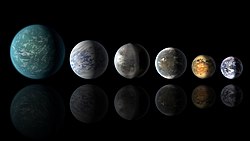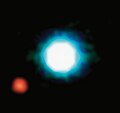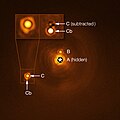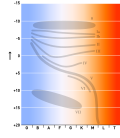A substellar object, sometimes called a substar, is an astronomical object, the mass of which is smaller than the smallest mass at which hydrogen fusion...
7 KB (881 words) - 13:21, 9 December 2024
J1407b (category Free-floating substellar objects)
J1407b is a substellar object, either a free-floating planet or brown dwarf, with a large circumplanetary disk or ring system. It was first detected by...
39 KB (3,923 words) - 23:05, 28 April 2025
end as dispersed cold particles or some form of compact stellar or substellar object, according to thermodynamics. The stars called white or degenerate...
20 KB (2,589 words) - 22:40, 1 March 2025
This article documents the most distant astronomical objects discovered and verified so far, and the time periods in which they were so classified. For...
147 KB (8,977 words) - 16:31, 27 April 2025
Young stellar object (YSO) denotes a star in its early stage of evolution. This class consists of two groups of objects: protostars and pre-main-sequence...
5 KB (614 words) - 19:45, 23 January 2025
Brown dwarf (category Substellar objects)
Brown dwarfs are substellar objects that have more mass than the biggest gas giant planets, but less than the least massive main-sequence stars. Their...
166 KB (18,161 words) - 03:40, 28 April 2025
any white dwarf to have yet cooled to "black". A brown dwarf is a substellar object not massive enough to ever fuse hydrogen into helium, but still massive...
5 KB (577 words) - 19:34, 24 April 2025
also been applied to hypothetical late-stage cooled brown dwarfs – substellar objects with insufficient mass (less than approximately 0.07 M☉) to maintain...
10 KB (1,157 words) - 16:53, 15 April 2025
A Thorne–Żytkow object (TŻO or TZO), a type of hybrid star, is a conjectured type of star wherein a red giant or red supergiant contains a neutron star...
18 KB (1,742 words) - 15:09, 14 April 2025
gravitationally bound non-stellar objects in orbit around a star or star system Substellar object – Astronomical object without the mass to sustain hydrogen...
2 KB (190 words) - 10:54, 23 June 2024
nighttime, albedo describes solar reflections from other Solar System objects, including moonlight, planetshine, and zodiacal light. Observation and...
14 KB (1,695 words) - 03:06, 17 July 2024
Deuterium fusion (section In substellar objects)
burning, is a nuclear fusion reaction that occurs in stars and some substellar objects, in which a deuterium nucleus (deuteron) and a proton combine to form...
12 KB (1,354 words) - 06:33, 26 January 2025
2007 was interpreted as a substellar object with a circumstellar disk or massive rings transiting the star. This substellar object, dubbed "J1407b", is most...
39 KB (3,943 words) - 17:24, 11 April 2025
Herbig–Haro (HH) objects are bright patches of nebulosity associated with newborn stars. They are formed when narrow jets of partially ionised gas ejected...
36 KB (4,001 words) - 20:11, 15 March 2025
Sub-brown dwarf (category Free-floating substellar objects)
planet Hot Jupiter Red dwarf Rogue planet Substellar object List of planet types Lists of astronomical objects Working Group on Extrasolar Planets – Definition...
11 KB (1,382 words) - 22:48, 15 March 2025
is no hydrostatic equilibrium at or below this limiting temperature. The object would then quickly dissipate, leaving behind the intermediate mass black...
9 KB (1,036 words) - 13:44, 4 April 2025
Rogue planet (redirect from Interstellar planetary mass object)
NIRCam data and found that most JuMBOs did not appear in his sample of substellar objects. Moreover the color was consistent with reddened background sources...
87 KB (8,509 words) - 09:43, 1 May 2025
Solar System (section Extreme trans-Neptunian objects)
The Solar System is the gravitationally bound system of the Sun and the objects that orbit it. It formed about 4.6 billion years ago when a dense region...
224 KB (21,993 words) - 02:39, 2 May 2025
V1400 Centauri (redirect from Mamajek's object)
pre-main-sequence star that was eclipsed by the likely free-floating substellar object J1407b in April–June 2007. With an age around 20 million years, the...
30 KB (2,802 words) - 00:12, 20 March 2025
2M1207 (category Free-floating substellar objects)
Carpenter, J. M.; Bowler, B. P. (2017-07-01). "ALMA Observations of the Young Substellar Binary System 2M1207". The Astronomical Journal. 154 (1): 24. arXiv:1706...
13 KB (1,262 words) - 08:46, 27 July 2024
initially in balance between self-gravity, which tends to compress the object, and both gas pressure and magnetic pressure, which tend to inflate it....
10 KB (1,217 words) - 10:54, 5 April 2025
HIP 81208 (category Henry Draper Catalogue objects)
Scorpius–Centaurus association. In 2023, HIP 81208 C was found to be orbited by a substellar object, which is at the border between being a massive exoplanet and a low-mass...
13 KB (1,036 words) - 15:31, 7 April 2025
CWISE J0506+0738 (category Astronomical objects discovered in 2023)
exceptionally red substellar object, likely located in the Beta Pictoris moving group. CWISE J0506+0738 was first noticed as a high proper motion object in WISE...
6 KB (564 words) - 19:23, 2 November 2024
astrophysics, a gravastar (a blend word of "gravitational vacuum star") is an object hypothesized in a 2001 paper by Pawel O. Mazur and Emil Mottola as an alternative...
14 KB (1,408 words) - 04:08, 2 May 2025
"Discovery of a close substellar companion to the hot subdwarf star HD 149382 — the decisive influence of substellar objects on late stellar evolution"...
18 KB (2,103 words) - 01:30, 6 December 2024
Cha 110913−773444 (category Free-floating substellar objects)
Cha 110913−773444 (sometimes abbreviated Cha 110913) is an astronomical object surrounded by what appears to be a protoplanetary disk. It lies at a distance...
4 KB (304 words) - 15:42, 21 December 2024
planets. Notable neutron stars, black holes, and other exotic stellar objects/remnants. Note that these lists are currently unfinished, and there may...
7 KB (415 words) - 21:15, 17 April 2023
"Distances, Luminosities, and Temperatures of the Coldest Known Substellar Objects". Science. 341 (6153): 1492–1495. arXiv:1309.1422. Bibcode:2013Sci...
318 KB (18,542 words) - 05:15, 5 May 2025
The magnetospheric eternally collapsing object (MECO) is an alternative model for black holes initially proposed by Indian scientist Abhas Mitra in 1998...
10 KB (1,170 words) - 07:13, 12 November 2024
Chabrier, G.; Baraffe, I. (2000). "Theory of low-Mass stars and substellar objects". Annual Review of Astronomy and Astrophysics. 38: 337–377. arXiv:astro-ph/0006383...
154 KB (17,961 words) - 03:09, 21 April 2025






















